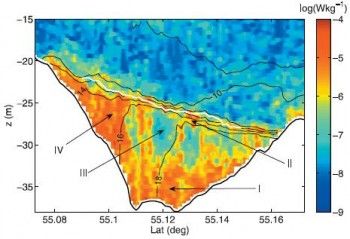
Dynamics of rotating gravity currents

Gravity currents in rotating reference frames are a fascinating and, due to their importance for the ocean general circulation, intensively studied topic. Gravity currents in the virtually tideless Baltic Sea occur at much shallower depths and exhibit smaller spatial scales than their large-scale counterparts in the deep ocean. Nevertheless, they share many features with these large-scale overflows, e.g. the high Reynolds numbers, strong rotational effects, and subcritical Froude numbers. The smaller spatial scales make the gravity currents in the Baltic more easily accessible for high-resolution measurements of hydrographic and turbulence parameters. We exploit this advantage, and use the Baltic Sea as a natural laboratory for deriving generally applicable models of rotating bottom gravity currents (Umlauf and Arneborg 2009a,b; Arneborg et al., 2007; Umlauf et al., 2007).
As an example for the available data sets, the figure to the right shows a complete microstructure and CTD transect across a gravity current passing through an approximately 10 km wide channel in the Western Baltic. The high sampling density (more than 70 profiles for this figure) allowed us to compute detailed transects of turbulence parameters across the whole width of the gravity current, from which the essential non-dimensional numbers describing rotating gravity currents can be derived: the Froude number, the Ekman number, the entraiment rate, the drag coefficient, etc. We collaborate with colleagues from IOW's regional ocean modeling group to gain a better understanding of the physical processes in such flows (Umlauf et al., 2010), and with researchers from other disciplines to investigate the biogeochemical implications of mixing in gravity currents (Schmale et al., 2016).